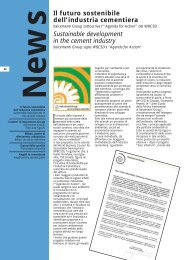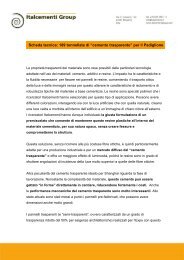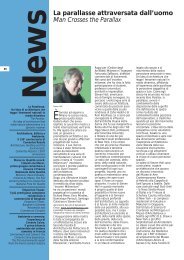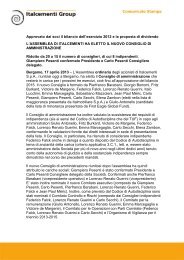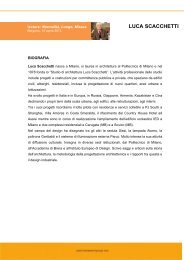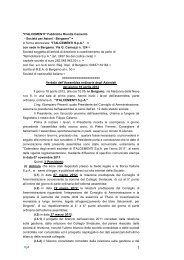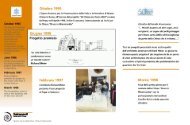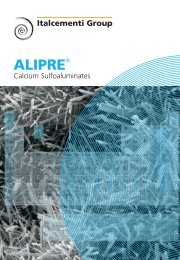2011 Annual Report - Italcementi Group
2011 Annual Report - Italcementi Group
2011 Annual Report - Italcementi Group
Create successful ePaper yourself
Turn your PDF publications into a flip-book with our unique Google optimized e-Paper software.
Associates<br />
Associates are companies in which the <strong>Group</strong> has significant influence over administrative and management<br />
decisions even though it does not hold control. Generally speaking, significant influence is assumed to exist<br />
when the <strong>Group</strong> holds, directly or indirectly, at least 20% of voting rights or, even if it holds a lower percentage<br />
of voting rights, when it is entitled to take part in financial and management policy decisions by virtue of a<br />
specific juridical status including, but not limited to, participation in voting trusts or other forms of material<br />
exercise of rights of governance. Investments in associates are measured using the equity method, whereby<br />
they are recognized initially at cost, and subsequently adjusted to reflect changes in the <strong>Group</strong>’s interest in the<br />
associate’s equity. The <strong>Group</strong>’s share of an associate’s profit or loss is recognized in a specific income<br />
statement line item from the date at which the <strong>Group</strong> exerts significant influence until it relinquishes such<br />
influence.<br />
Joint ventures<br />
Joint ventures are companies whose business operations are controlled by the <strong>Group</strong> jointly with one or more<br />
other parties, under contractual arrangements. Joint control presupposes that strategic, financial and<br />
management decisions are taken with the unanimous consent of the parties that control the venture.<br />
Interests in joint ventures are consolidated on a proportionate basis, whereby assets, liabilities, income and<br />
expense are recognized proportionately to the <strong>Group</strong>’s interest.<br />
The equity and income of joint ventures are consolidated from the date on which joint control is assumed and<br />
until such control is relinquished.<br />
Transactions eliminated during consolidation<br />
All intragroup balances and transactions, including any unrealized gains in respect of third parties, are<br />
eliminated. Unrealized losses deriving from intragroup transactions are eliminated, except in cases where it will<br />
not subsequently be possible to recover such losses.<br />
Unrealized gains deriving from transactions with associates are eliminated against the equity investment<br />
carrying amount, while losses are eliminated proportionately to the <strong>Group</strong>’s interest, unless it will not<br />
subsequently be possible to recover such losses.<br />
Scope of consolidation<br />
A list of the companies consolidated on a line-by-line basis, on a proportionate basis and with the equity<br />
method is provided in the annex to these notes.<br />
Non-current assets held for sale and discontinued operations<br />
Assets and liabilities held for sale and discontinued operations are classified as such when their carrying<br />
amount will be recovered chiefly through sale rather than through continuing use; such operations must be an<br />
important autonomous business operation or geographical area of operation.<br />
The conditions indicated are deemed to exist when the sale is considered highly likely and the assets and<br />
liabilities are immediately available for sale in their current condition.<br />
Available-for-sale assets are recognized at the lower of net carrying amount and fair value less costs to sell.<br />
Once property, plant and equipment and intangible assets have been classified as available-for-sale, no further<br />
amortization and depreciation may be applied.<br />
In the consolidated income statement, profit (loss) relating to discontinued operations, together with profit or<br />
loss from fair value measurement net of costs to sell and the profit or loss arising from the sale of the<br />
operation, are reflected in a single item separately from profit (loss) relating to continuing operations.<br />
Cash flows relating to discontinued operations are shown separately in the statement of cash flows.<br />
A similar disclosure is also presented for the comparative period.<br />
74






